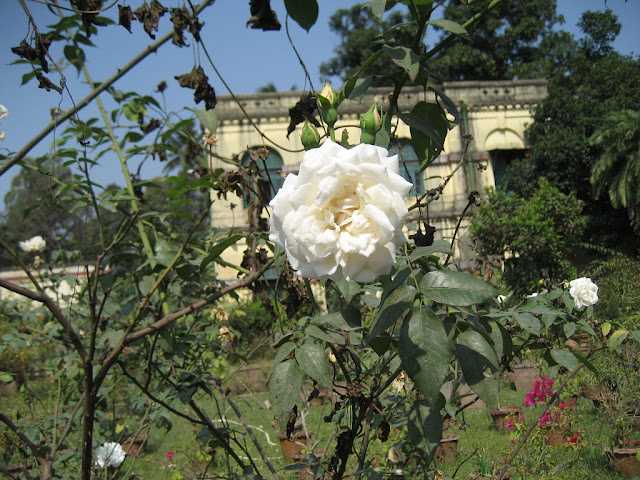| Our Professors :- Dr. Ashalata D'Rozario, M.Sc., Ph.D. , Head of the Dept. Sanjib Kr. Saha, M.Sc. Dr. Tandra Das, M.Sc., Ph.D. Dr. Aditi Saha, M.Sc., Ph.D. Ashim Chowdhury, M.Sc., B.Ed. M.Phil. (Part-time) Dr. Moumita Dutta, M.Sc., Ph.D. (Part-time) |
Tour At Acharya Jagadish Chandra Bose Indian Botanical Garden, Howrah :-
The Botany Educational Tour to Acharya Jagadish Chandra Bose Indian Botanical Garden, Howrah, was organised by our Botany Dept. with the 2rd year Bio Science ( Botany General / Anthropology Honours & Zoology Honours ) student in 15th Feb' 2012, as per syllabus of Botany, new regulation B.sc (1+1+1) of Calcutta University. The Team was guided by our respected and beloved prof. Dr. Ashalata D'Rozario, M.Sc., Ph.D , Prof. Ashim Chowdhury, M.Sc., B.Ed. M.Phil, Prof. Sanjib Kr. Saha, M.Sc, Prof. Dr. Tandra Das, M.Sc., Ph.D, & Supporting Staff Nemai Chandra Das.
In the Morning of 3rd February we reached at the gate of the Botanical Garden, Howrah, as per the direction of our respected prof. After that we entered in the garden in guidence of the prof. Ultimately we started our servey about the various types of trees & shrubs, and we noted the various details of those plants in our notebook, and we took their snapshot. We getting many various valuable details from our respected Prof.
About The Garden:-
The Acharya Jagadish Chandra Bose Indian Botanic Garden (previously known as Indian Botanic Garden) is situated in Shibpur, Howrah near Kolkata. They are commonly known as the Calcutta Botanical Garden, and previously as the Royal Botanic Garden, Calcutta. The gardens exhibit a wide variety of rare plants and a total collection of over 12,000 specimens spread over 109 hectares. It is under Botanical Survey of India (BSI) of Ministry of Environment and Forests, Government of India.
The best-known landmark of the garden is The Great Banyan, an enormous banyan tree (Ficus benghalensis) that is reckoned to be the largest tree in the world, at more than 330 metres in circumference. They are also famous for their enormous collections of orchids, bamboos, palms, and plants of the screw pine genus (Pandanus).
The gardens were founded in 1787 by Colonel Robert Kyd, an army officer of the British East India Company, primarily for the purpose of identifying new plants of commercial value, such as teak, and growing spices for trade. Joseph Dalton Hooker says of this Botanical Garden that "Amongst its greatest triumphs may be considered the introduction of the tea-plant from China ... the establishment of the tea-trade in the Himalaya and Assam is almost entirely the work of the superintendents of the gardens of Calcutta and Seharunpore (Saharanpur).
A major change in policy, however, was introduced by the botanist William Roxburgh after he became superintendent of the garden in 1793. Roxburgh brought in plants from all over India and developed an extensive herbarium. During the first twenty years especially of Nathaniel Wallich's superintendence, it "... contributed more useful and ornamental tropical plants to the public and private gardens of the world than any other establishment before or since. ... I here allude to the great Indian herbarium, chiefly formed by the staff of the Botanic Gardens under the direction of Dr. Wallich, and distributed in 1829 to the principal museums of Europe." This collection of dried plant specimens eventually became the Central National Herbarium of the Botanical Survey of India, which comprises 2,500,000 items.
Over the years attractive display gardens for the public have been developed and many kinds of plants have been cultivated for scientific observation. During the 1970s the garden initiated a program to introduce improved food plants and other varieties of economic benefit to the people of India.
Indian Botanical Gardens can be reached by taking a ferry service from Bichali Ghat, in Metiabruz. Presently, the easiest way to reach there is by passing over the Vidyasagar Setu as one of the exits from this bridge leads to the garden.
The Indian Botanic Garden was designated the Acharya Jagadish Chandra Bose Indian Botanic Garden on June 25, 2009 in honor of Jagadish Chandra Bose, the Bengali polymath, and natural scientist.
You can find The Bengal Fox (Vulpes bengalensis), also known as the Indian Fox inside the park premises. Also recently collection of park fee have started which is Rs. 5.00 per person. There is a complete ban on carrying plastic/polythene carrybags, bottles, wrappings etc.
Some Snapshots of the garden:-





























Darun hoyeche re.... Good... Parle amader college niye ekta banas...
ReplyDelete(Sapto Da, Bio)